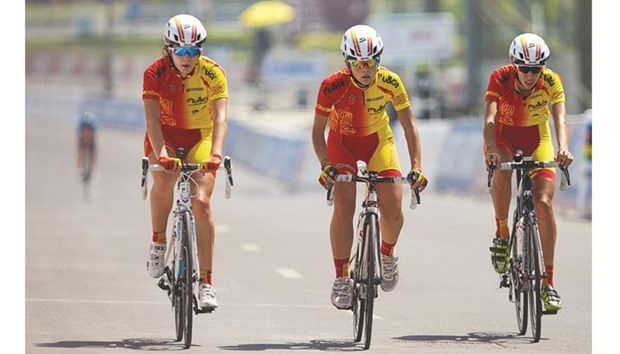With both individual and team time trials done and dusted, the UCI Road World Championships Doha 2016 will enter a new stage starting today with the men’s Under-23 Road Race.
It’s time for the Road Races, a completely different event where strategy comes into play. Unlike the time trial events, in Road Races all riders start at the same time. The course is way longer, making endurance a key factor. Having energy is as important as saving it. Staying behind your teammates and rivals, to avoid headwind is as important moving ahead when you get closer to the finish.
As for tactics, a cyclist’s main purpose during a Road Race is to avoid wasting energy. Waiting until the last few hundred metres to sprint toward the finish is a strategy the faster cyclists use often, but also it also has its own risks.
To start with, being in the right position in the final metres is crucial and hence there is a lot of contention for that. Secondly, a group of attackers might break away from the peloton during the race and make it all the way to the arrival, thus leaving only scraps for those in the bunch.
The men’s Under-23 Road Race field, comprising world’s best male riders aged between 19 and 22 years old, will aim for the rainbow jersey to propel their career to stardom.
Norway’s Kristoffer Halvorsen and Slovakia’s Erik Baska are the main favourites for a sprint, while Netherland’s Cees Bol and Italy’s Simone Consonni, the 2015 silver medallist, seem to be the best candidates for a successful breakaway.
Last year’s event, held in Richmond (Virginia, USA), was decided in an uphill section close to the finish line where strong riders made their move and sprinters did their best to hold their wheel and beat them in the last metres.
French powerhouse Kevin Ledanois won the rainbow jersey beating Consonni. With Ledanois, 23, moving out of the category, Consonni has another shot at the jersey.
Today, the powerhouses will have a chance of breaking away and keeping the peloton at bay to fight for the big prize, given the smaller size of the teams (6 riders max) and a technical circuit around The Pearl. However, a mass sprint finish cannot be completely ruled out.
Halvorsen has proven his credentials by dominating the sprints at the Tour de l’Avenir, the world’s best U23 stage race. Pascal Ackermann, a great sprinter in his own right will share the German Team captaincy with an already established pro such as Phil Bauhaus.
Talking about established pros, Colombia’s Sebatián Molano has already surprised older riders this season with his raw power. Meanwhile, Italy will line up an outstanding team with Jakub Mareczko as star rider and Vincenzo Albanese, Riccardo Minali and the aforementioned as back-up plans.
Slovakia’s Erik Baska has shone consistently this season in the WorldTour peloton, while Netherlands’ Cees Bol proved his worth recently in the Olympia’s Tour, a pan flat U23 stage race that has been used as launching pad by some riders set to take part in this exciting race.
Lastly we find two riders that have excelled in 2016. Belarus’ Alexandr Riabushenko, who won the European Championships RR, and Spain’s Iván García Cortina, who has been quite successful in 2016 having been placed inside the top 10 in 24 races over the last seven months.
The race will be held entirely in The Pearl. It comprises 10 laps of the 15.2 kilometre circuit, plus an initial partial lap for a total of 165.7 kilometres of racing. After four days of competition, the riders are now familiar with the curvy, flat nature of the course and aware of how to handle the bends and turns, but they have to withstand the added pressure of being packed between other riders and their bikes.

